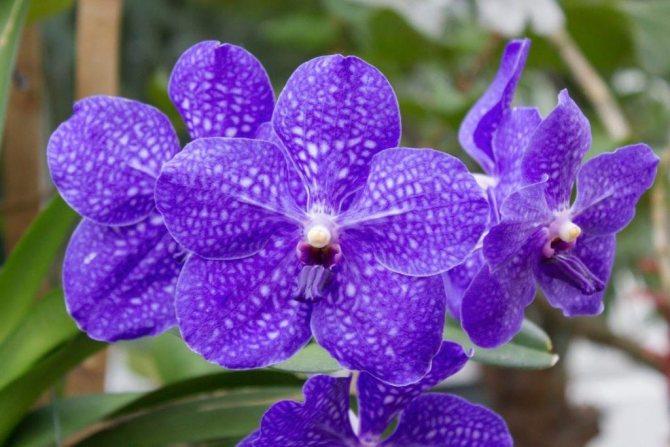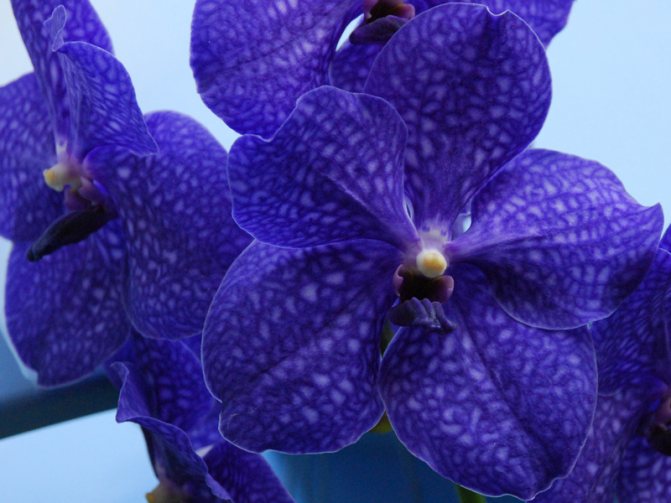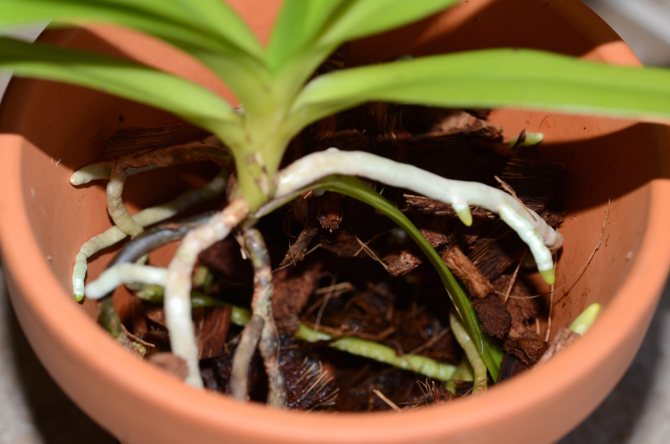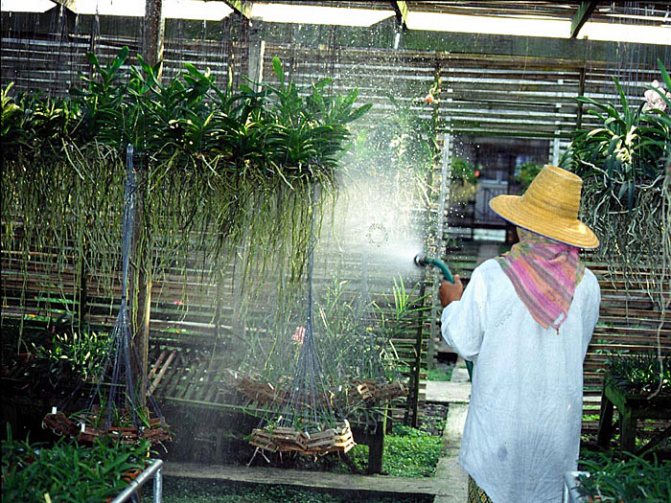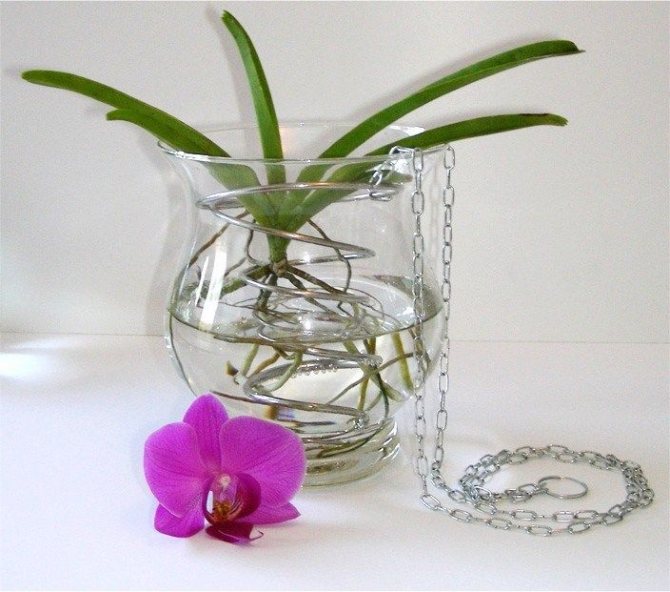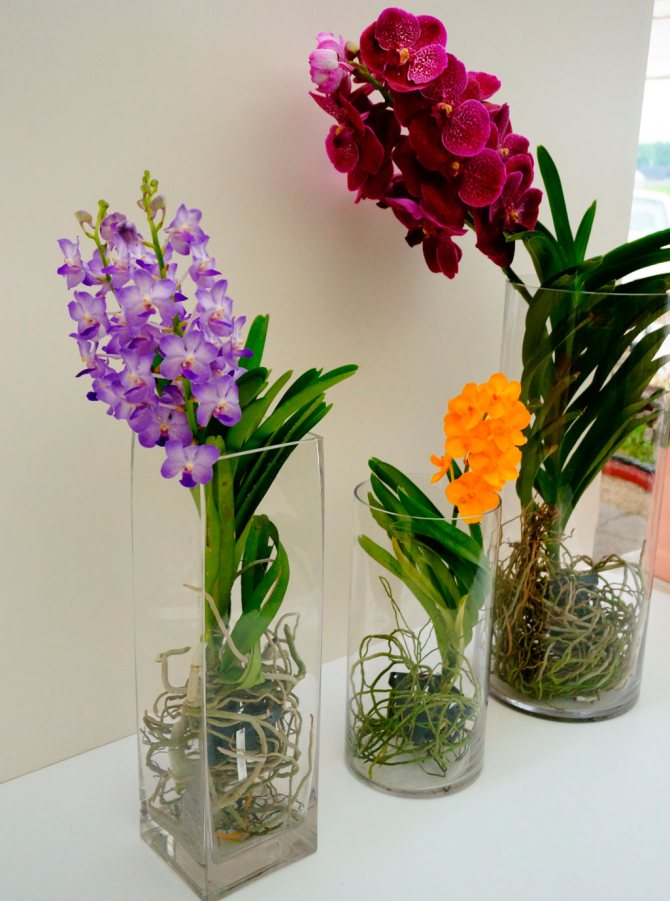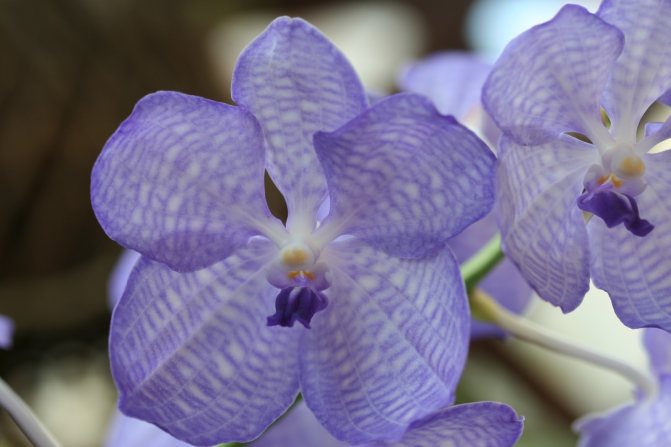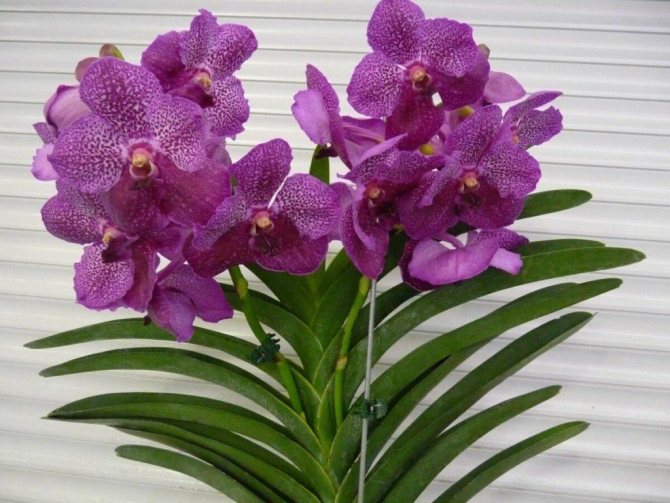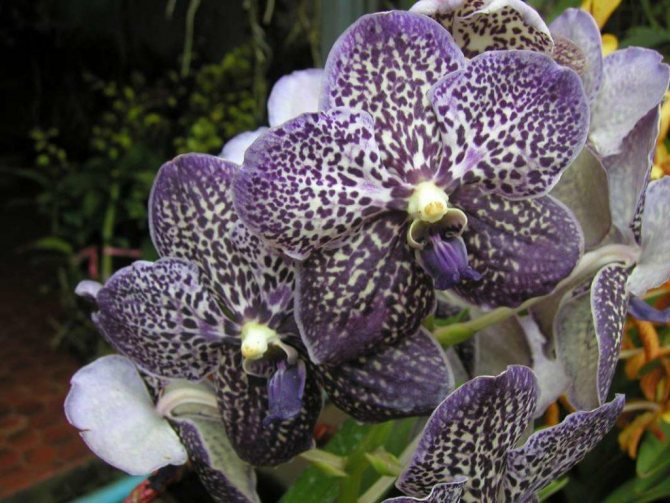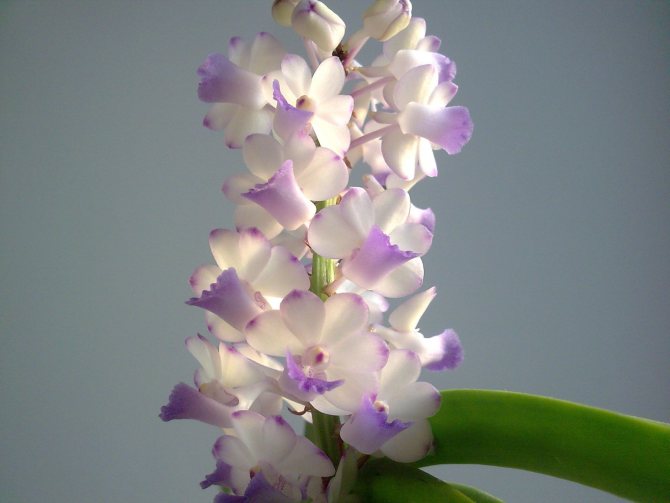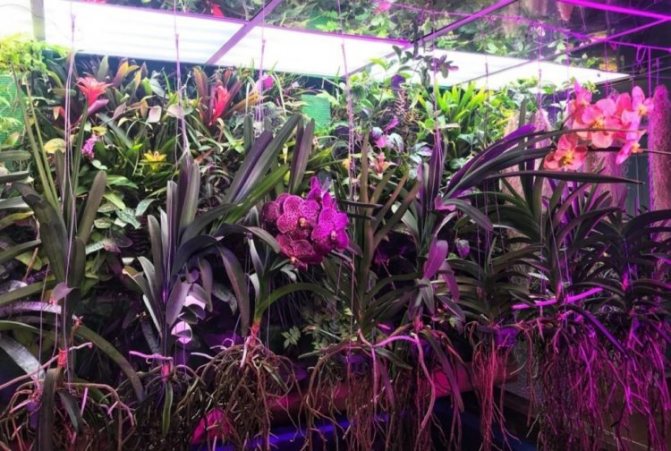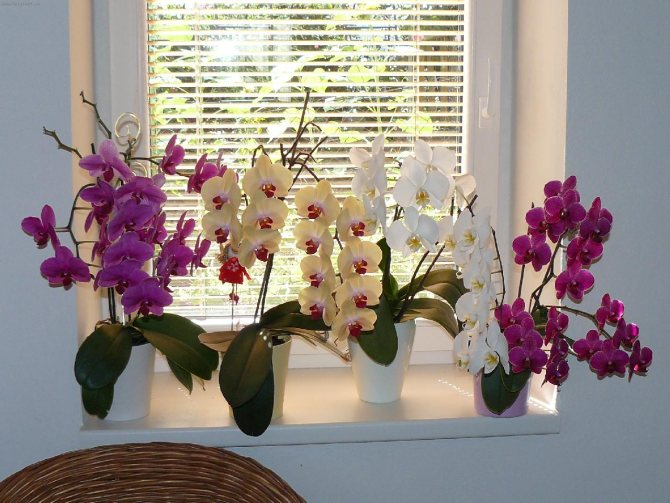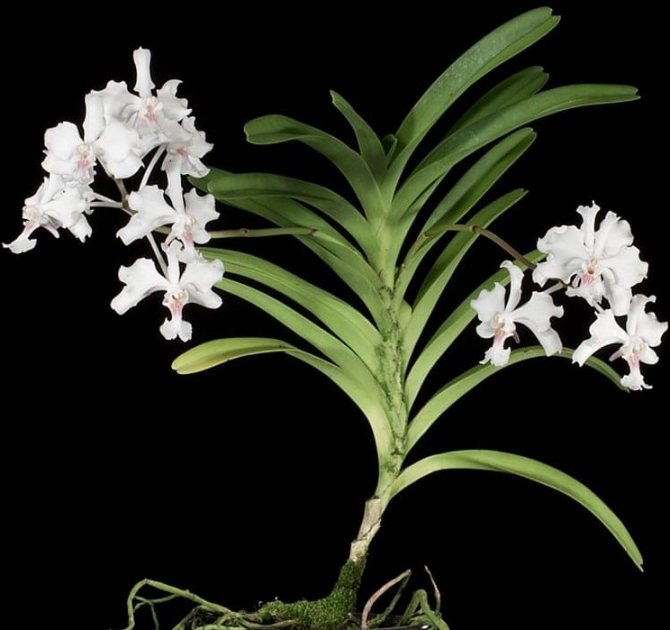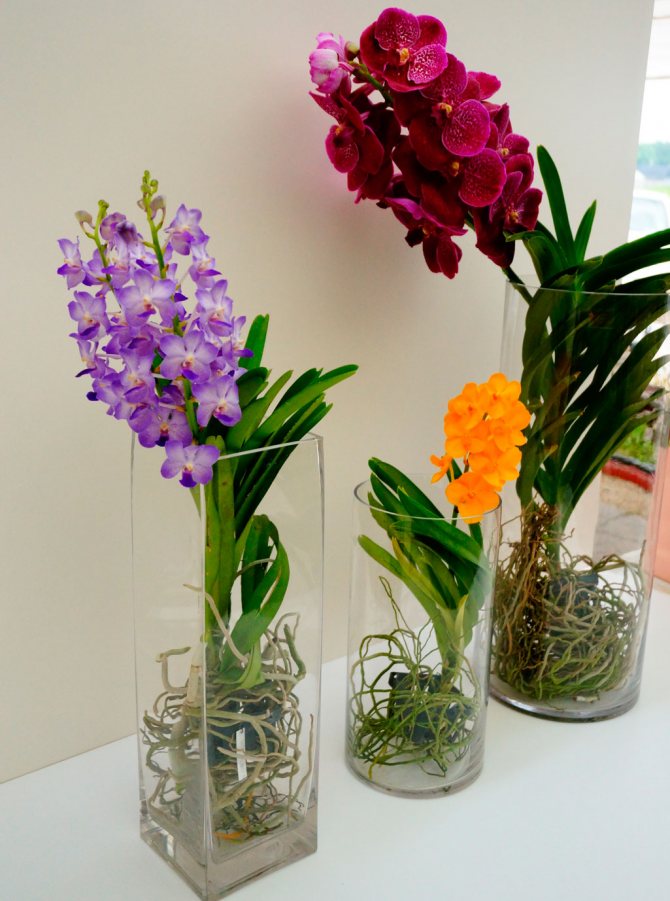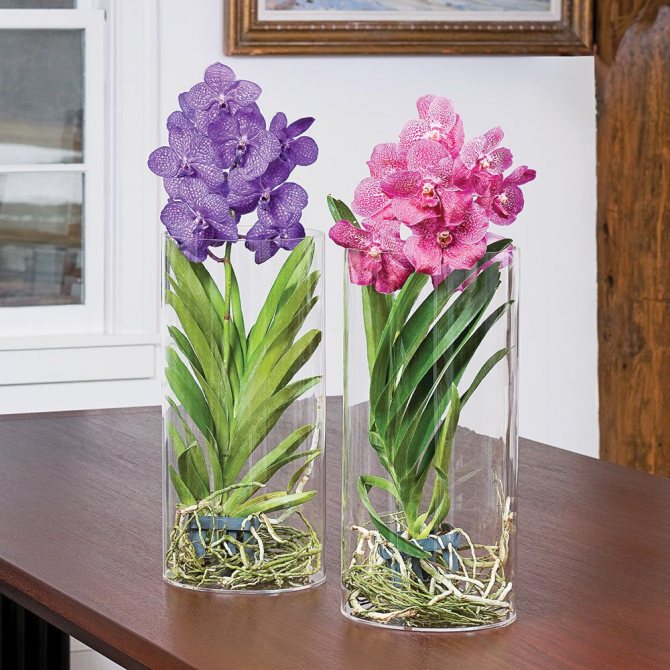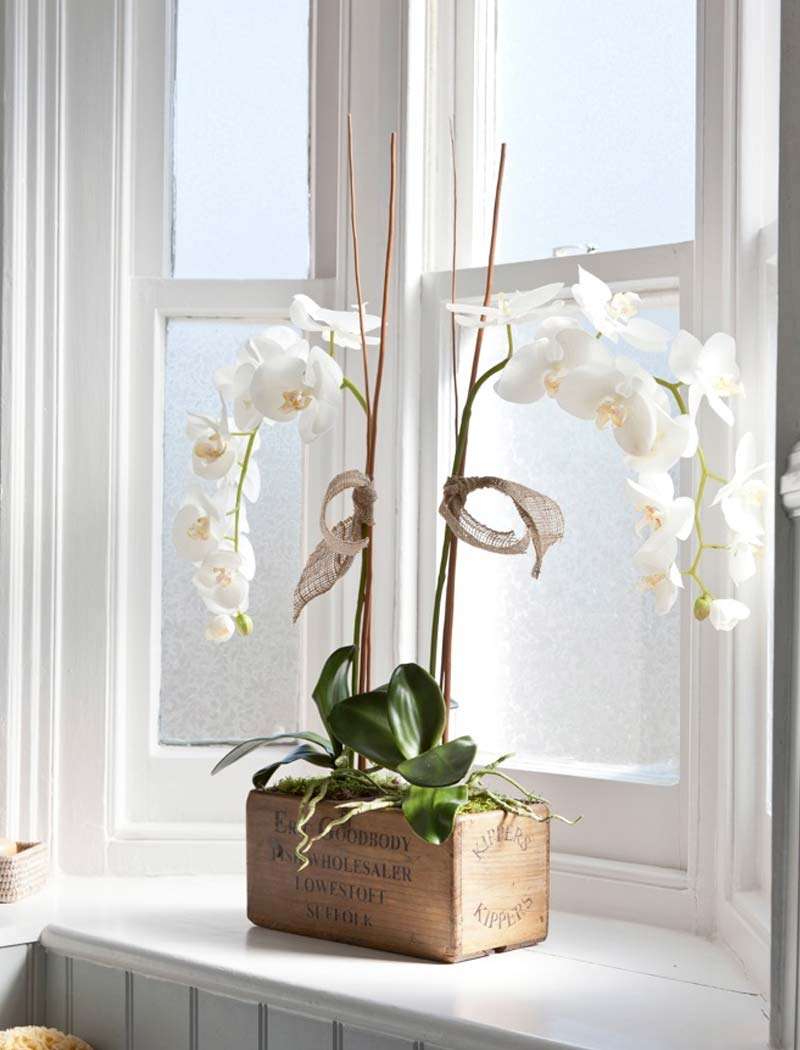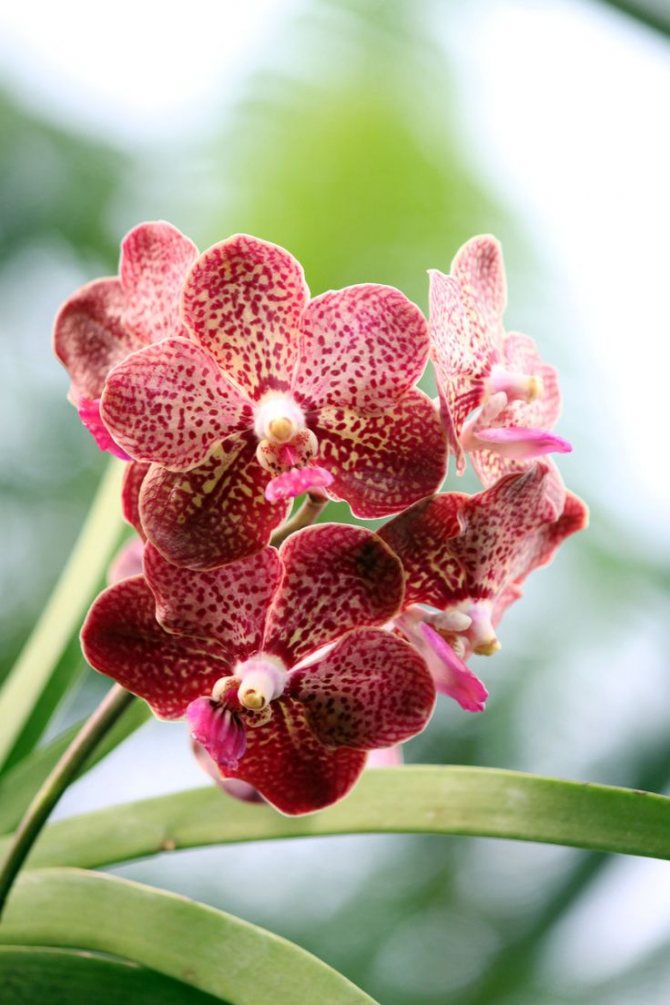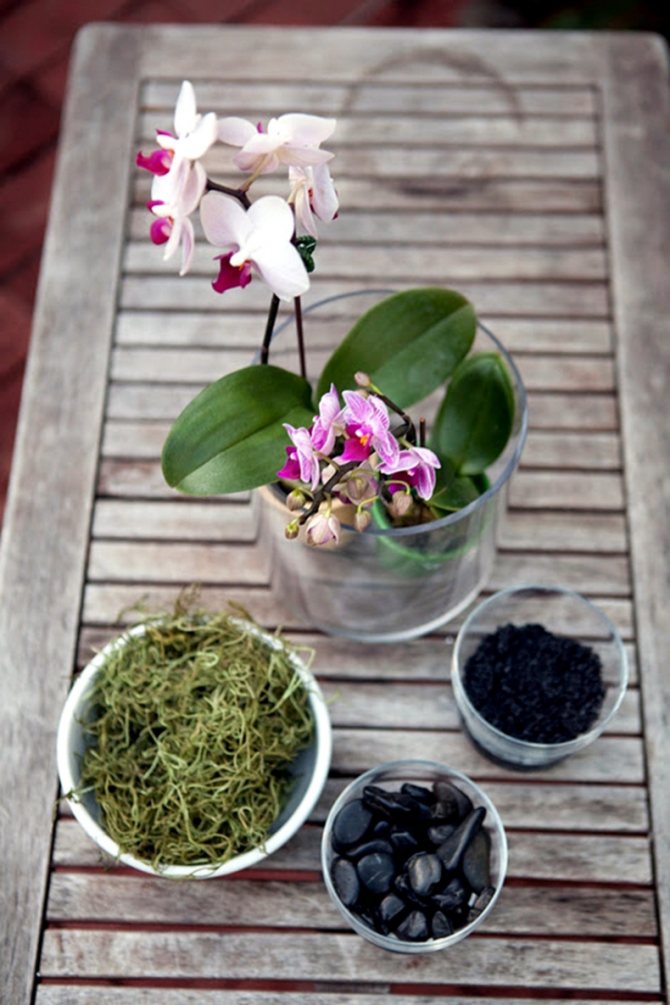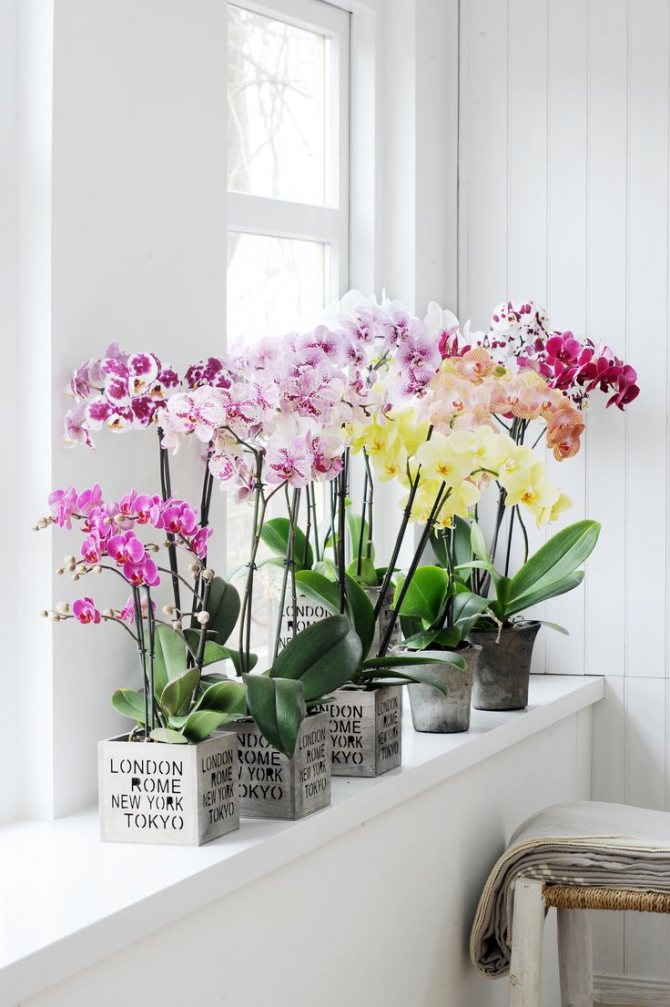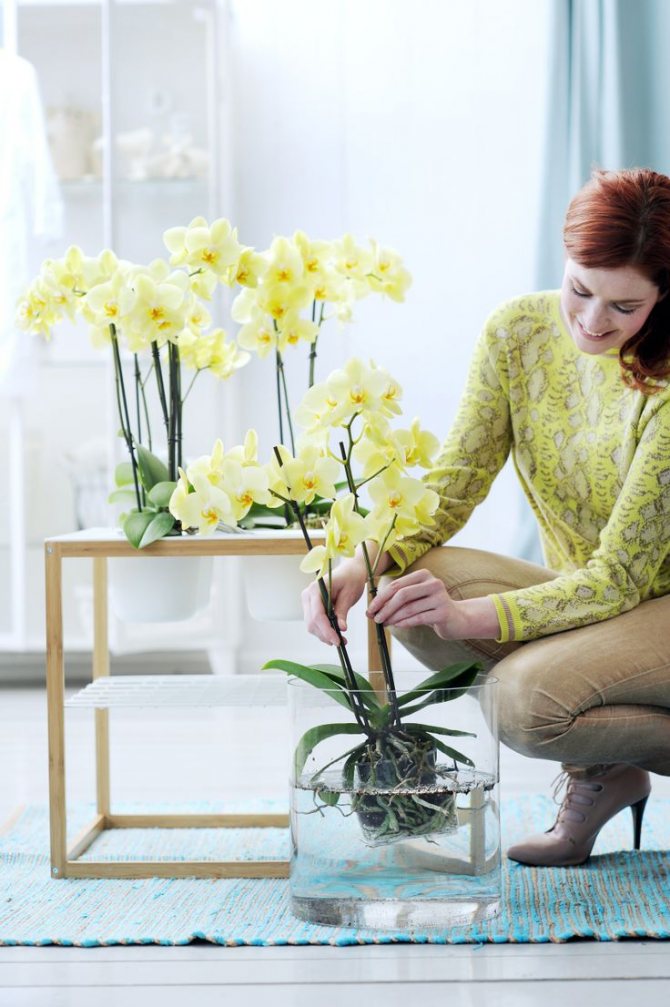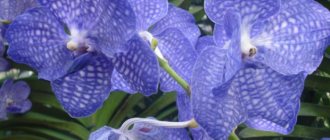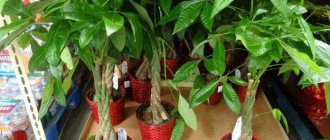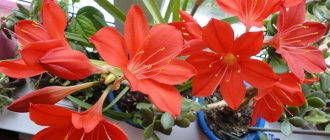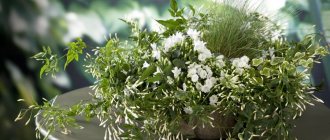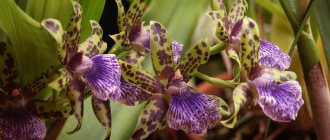For some reason, many people still believe that the orchid is too capricious and fastidious flower, which is completely impossible to grow at home, and therefore abandon their little dream. However, in fact, a very large number of gardeners are now growing orchids in their homes, and in order for you to do this too, we will reveal their secrets and tell you how to achieve bright, beautiful flowering and good health from the Wanda orchid in home conditions. However, this will take a lot of patience, diligence and effort.
Vanda orchid variety: photo
Origin and description of the Wanda orchid
Vanda Orchid is an incredibly beautiful epiphytic plant (a flower with aerial roots that grows naturally on trees) belonging to the Orchid family. The homeland of the orchid is the tropical regions of Asia, in particular, India, South China, Thailand, the Philippines, and the flower is also found in the northern part of Australia.

Wanda is an epiphytic orchid with long aerial roots and gorgeous fragrant flowers
A distinctive feature of the Vanda orchid is its powerful roots, covered with velamen - a thick, porous layer of dead cells, thanks to which the plant can absorb moisture even from the air, thereby protecting from dehydration and sunburn.
Wanda is a monopodial orchid, its stem only grows upward and reaches one meter in height... The shoot is covered with belt-like or cylindrical leaf blades from the rhizome to the inflorescence. Wanda's leaves are leathery, bright green or slightly bluish in color, arranged alternately on the shoot.
Peduncles grow from leaf sinuses. They bloom amazing flowers of various shades of lavender, pink and purple. On the petals there may be a mesh of veins of a darker tone.
The flowering period of Wanda is very long, it can last up to three months.
Diseases and pests of this type of orchid, how to deal
Wanda is susceptible to several diseases and pests. Insects such as scale insects, mealybugs, mites, thrips and aphids do not often infect it, unlike other members of the orchid genus. And here diseases can be as follows:
- Fusarium Is the most common Wanda disease. It appears as dark spots at the base of the sheets. Prophylaxis - systematic disposal of dead roots and yellowed leaves. Treatment - orchid treatment with foundation.


Fusarium Wanda
- Bacterial rot... For treatment, an antibiotic solution is used, as well as Fundazol or Fitosporin.
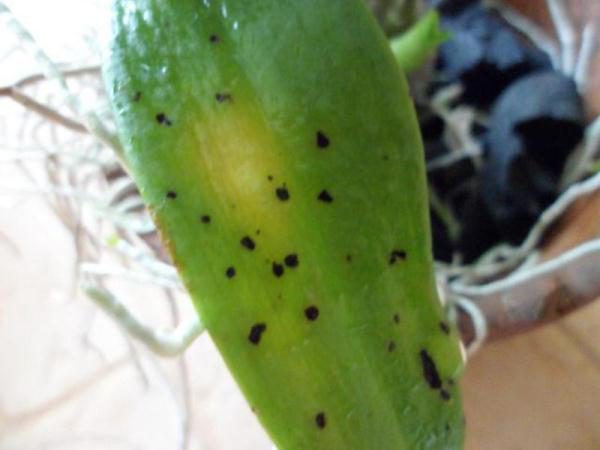

Bacterial rot on the leaves of the Wanda orchid
Possible violations resulting from improper care:
- Rotting trunk and leaves, as well as softening and wrinkled leaves - occurs when waterlogged.
- Yellowing of leaves - in case of overheating and insufficient watering.
- Lack of flowering - occurs when there is a lack of light, an excess of nitrogen in the fertilizer or the absence of a temperature difference.
- The peduncle becomes brown and dies off - the cause of pest damage.
What to choose: Wanda blue and other species
In total, botanists have described about 50 species of the Wanda orchid found in nature, but only a few of them are grown in culture.
- Wanda is rolling. A distinctive feature of this species is a high branched stem, the size of which reaches three meters. The orchid has multiple powerful roots and leaf blades about 20 cm long. From 3 to 6 large buds bloom on the peduncle, exuding a pleasant aroma.
- Wanda is blue. The orchid of this species has a straight stem that grows up to one meter, and many aerial roots. The leaf blades are dense, belt-shaped, with an oblique cut in the upper part. Wanda blue produces a large peduncle up to 0.6 m long, on which from 6 to 15 flowers of various shades of lavender bloom. The lip is colored in a brighter tone than the rest of the petals.
- Wanda tricolor. The erect stem of this species reaches a height of 1.5 to 2 m. The peduncle does not stretch more than 0.3 m, but about ten fragrant large flowers of a white or cream shade with brown or red-brown spots bloom on it. The teardrop-shaped sepals and petals have wavy edges.
- Wanda Sandera. This type of orchid is a national flower and property of the Philippines, it is endangered, therefore it is prohibited to export from the country. However, on sale you can find hybrids that have retained the species characteristics, namely, rigid, belt-like leaf blades with a forked tip and erect long peduncles with a dozen buds on each.
- Chess Wanda. The stem of this species is hidden under narrow, light green leaves. The length of the peduncles can be up to 0.5 m, while each of them blooms up to 12 buds. The sepals and dark-veined petals are painted in a variety of shades of yellow, beige and brown, and the lip is in contrasting shades of pink or purple.
- Wanda Javiera... It is the only natural species with snow-white flowers. In nature, it is found on only a few islands of the Philippine archipelago. It is compact in size and grows only up to 35 cm.
Instances of this species became the progenitors of several varieties with snow-white buds, the most popular of which are Sunny White Beauty, Wanda Candida, White Magic, Mikassa White.
- Wanda Suarez (gentle). The shoot, reaching 90 cm in length, bears belt-like leaves of a dark green color. The inflorescence consists of 10-12 fragrant buds, the diameter of which is 5-7 cm. The petals and sepals with wavy edges are painted white and covered with purple dots. The lip is bright pink, three-lobed.
- Wanda is great. This species is a large orchid with a thick, fleshy stem and tough leaf blades. The inflorescence is collected in a cluster of several flowers, colored in shades of yellow and brown. The buds are small, their diameter is 4–5 cm. The lip is rounded and colored pink.
- Wanda blushing. A very spectacular view found on the island of Java and in the tropical forests of Malaysia. Differs in strong fleshy shoot and elongated leaf blades of bright green color. The inflorescence consists of five shiny flowers, exuding a delicate sweetish odor. The color of the buds is dominated by all sorts of shades of red, from coral to purple.
- Wanda Stanja. Representatives of this species grow in Nepal and India. The peduncle is small (only 10–12 cm in length); yellowish-green waxy flowers bloom on it, the diameter of which is only 3 cm.
- Wanda Yuesty. It is noteworthy that this species received its name in honor of the University of St. Thomas in Manila (abbreviation for the name of the educational institution - UST), of which she is a symbol. The only habitat is mountain forests in the Philippines. A distinctive feature is the yellow flowers with a bright pink lip.
In flower shops, they usually sell not pure Wanda orchid species, but interspecific and intergeneric hybrids.... These plants are not so capricious and are adapted for growing at home.Most often, you can find Ascocend and Izaoara on sale.
Ascocenda is a hybrid obtained by crossing Wanda and Ascocentrum, and Isaoara is a hybrid whose parents were plants from four different genera: Aerides, Phalaenopsis, Ascocentrum and Wanda.
Photo gallery: almost all colors except blue are Wanda orchid varieties


Wanda roll has powerful roots


Wanda's blue stem grows up to one meter Javier is the only natural species of Wanda orchid with white flowers


Wanda Sandera is considered the national flower of the Philippines The petals and sepals of Wanda Suarez are white, covered with purple dots


The lip of Wanda tricolor resembles the outlines of a human figure


The sepals and petals of the chess Wanda have dark streaks.
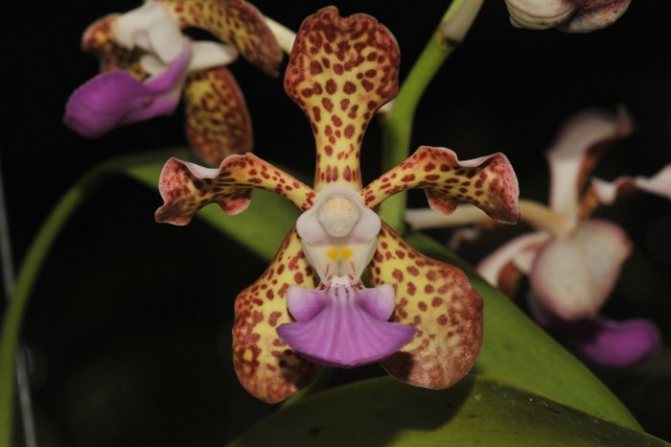

The inflorescence of Wanda the Great is collected in a cluster of flowers, painted in shades of yellow and brown
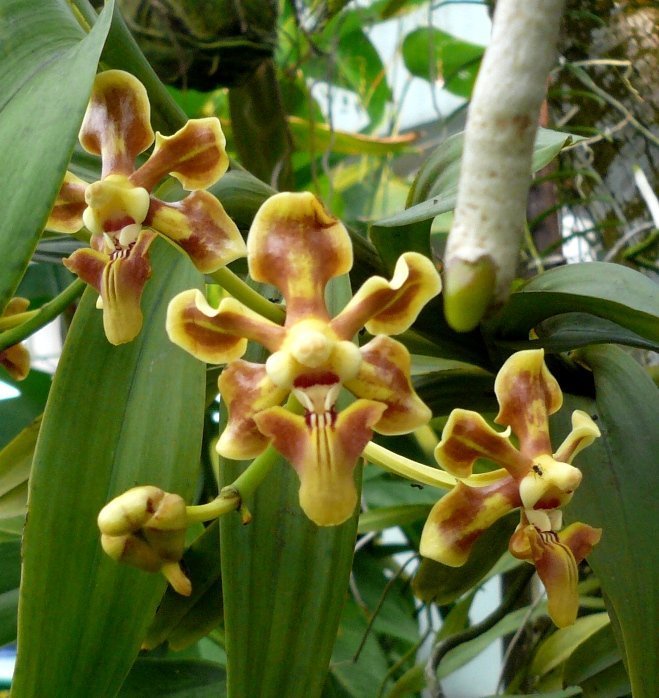

The flowers of Vanda blushing are painted in shades of red
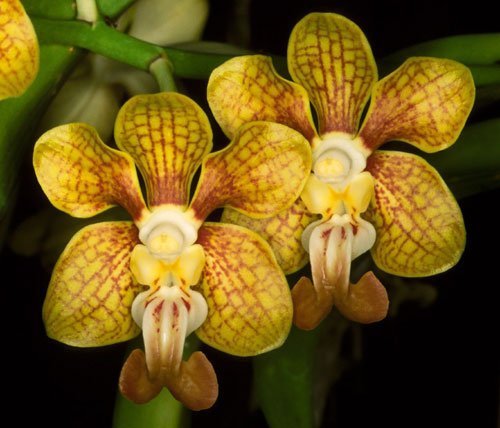

Wanda Stanja has a compact shape


Wanda Yuesti's only habitat is in the mountain forests of the Philippines.
Benefit
The Vanda Orchid has some medicinal properties and is capable of pain relieving properties.


Orchid-based preparations are used to treat:
- radiculitis;
- rheumatism;
- neuralgia;
- gastrointestinal, gynecological and urological diseases;
- also used as a remedy for the healing of ulcers and wounds.
On the basis of orchids are made:
- antidotes for snake bites;
- stimulating and tonic drinks;
- medicated oils;
- immunostimulating drugs;
- medicines against puffiness and to enhance potency.
Also:
- Some preparations obtained from the Wanda orchid have the ability to accelerate the healing of bone fractures.
- Tea from the flowers of this plant helps to lower blood pressure and immerse yourself in restful sleep.
- Vanda orchid leaves are used to regulate the immune system and treat diabetes.
Lamp for the winter and other conditions required depending on the season - table
| Season | Lighting | Humidity | Content temperature |
| Spring Summer | The orchid is very light-requiring, but can get burned from direct sunlight. The ideal option would be to be located on a window in a south or east orientation, but it is better to shade the flower with tulle from the scorching sun. | Humidity should be fairly high (at least 70%). You should spray the leaves as often as possible, trying to keep moisture out of the roots, and install a humidifier, a decorative fountain or a tray with wet pebbles next to the plant. | + 25-30 ° C during the day and 16-22 ° C at night |
| Autumn winter | The orchid needs to be supplemented with fluorescent lamps or special phytolamps. The flower should be exposed to light for up to 12 hours a day. |
| + 16-18 ° C during the day and not lower than + 12 ° C at night |
Wanda growing methods
Taking into account the peculiarities of the structure of the root system and the conditions of the Wanda orchid, there are three ways in which the flower feels comfortable.
Pot
You will need a large transparent plastic or clay container. The root system should not be cramped.
Several holes must be made at the bottom of the pot to ensure air circulation. The soil should contain pine bark, styrofoam, peat and charcoal. This substrate is sold in stores, but it can also be prepared at home.
Glass cylindrical vase
Only the root will be in the vase, because the upper part of the flower needs constant bright lighting.To water the orchid, you need to fill the vessel along the walls until the root system is completely submerged in water. After 30 minutes, drain the water. Soil is not required in this case. Thus, Wanda will organically fit into the interior.
Hanging baskets
There are also special hanging baskets for this kind of orchid. In them, the plant is located so that the entire root system is free, that is, outside the container. The method is popular due to the simplicity of watering the plant: you need to completely spray the flower about 2 times a week. In the summer, you should do this every day.
Landing nuances
The Wanda orchid does not tolerate transplantation very well, so the procedure should be carried out only in exceptional cases, for example, if the pot has become too small, or the flower needs to be reanimated if its roots have rotted. It is also recommended to transplant the orchid when the roots are too deeply embedded in the substrate or in the case when the old soil in the container is compressed and dries poorly.
What substrate can you take
In nature, Wandas are epiphytic plants that live on trees. Therefore, the substrate must allow air to flow to the roots and not retain moisture. The optimal soil composition is pine bark and sphagnum moss... These ingredients must be chopped and mixed. Experienced orchidists recommend adding pieces of charcoal, sand and expanded clay to the substrate.
It is very convenient to use a ready-made mixture for orchids, it contains all the necessary components.


Chopped pine bark is the optimal soil for Wanda.
Some experts believe that Wanda does not need soil at all for the development of Wanda. It can be placed in a plastic basket or simply secured to a piece of bark. Aerial roots will receive nutrients and moisture from the surrounding air.
Pot
Wanda can be grown in a regular clay pot or in a special plastic net. To cover the roots, it can be placed in a flowerpot, a special ceramic flowerpot with a large number of holes on the sides, or in a wicker basket.
Another effective way to grow Wanda is by placing the plant in a glass vase.
Orchid transplant
Step-by-step description of the process:
- Lay expanded clay or gravel drainage in a layer of 2-3 cm at the bottom of the container.
- Spread a layer of coarser bark and sphagnum moss on top of it.
- Remove Wanda from the old pot and carefully clean the roots of the soil.
- Examine the roots and cut out any dry or rotten ones. Sprinkle the slices with crushed activated carbon.
- Place Wanda in a pot and cover the roots in the middle with the finer bark.
- Spread the roots on the sides of the plant and place them behind the walls of the flowerpot.
- After transplanting, do not water the plant for 2-3 days.
Application in cosmetology
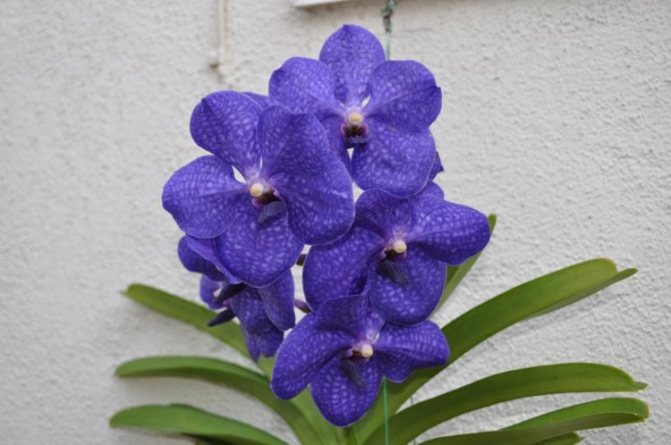

Wanda orchid extract and oil are widely used in many modern cosmetics, which:
- intensely moisturize and soften the skin;
- quickly and easily relieve irritation;
- are used for skin care of any type.
French scientists assure that it is quite possible to obtain a special extract from the root of the orchid, capable of:
- increase the elasticity of the skin;
- restore skin cells;
- activate the production of cytokine - a gene of longevity.
How to care
Watering nuances
An orchid requires alternating wet and dry cycles for excellent flowering. On hot summer days, it needs to be watered daily, and in autumn and winter, the number of waterings should be reduced to one in one or two days.
Please note that moisture should not stagnate at the roots, so after it drains, pour excess water from the pan.
An orchid can be watered in several ways. Among them:
- warm shower;
- immersion;
- watering the substrate with a watering can;
- spraying.
A warm shower can be arranged for the orchid weekly in the summer.... To do this, put the plant in a bath and pour warm water.Leave it for an hour to let all the water drain, then wipe the leaves with a soft cloth and drain off any excess water.
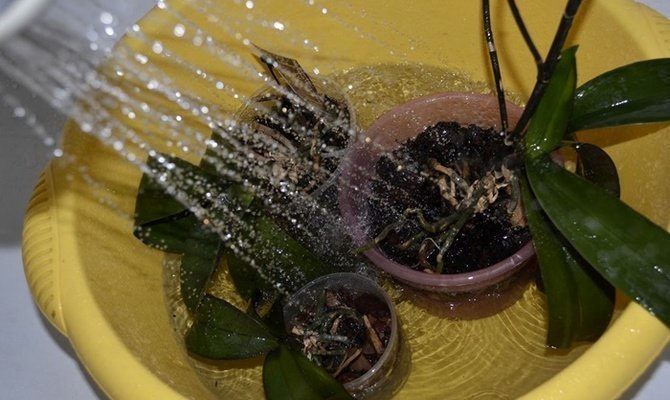

A warm shower is suitable for the plant as an additional watering option for the summer period.
Immersion irrigation method is very effective... To do this, pour water into a basin and place the pot with Wanda in it for about 20 minutes. During this time, the roots are saturated with moisture (a signal of this will be their greening), and the plant can be removed from the basin.
Watering with a watering can can be done daily on warm days. Moisten the substrate with warm, settled water, pouring it along the edge of the container.
Spraying is recommended several times a day during the hot season. Moisten only the orchid leaves in this way, being careful not to get the droplets on the aerial roots.
Top dressing
It is recommended to fertilize Wanda with preparations for orchids monthly when watering. To do this, dilute the fertilizer as indicated in the instructions and add it to the water. Pour the nutrient solution into a basin and place the orchid in it for about 30 minutes.
The specifics of growing in a vase or glass flask
On sale, Wanda can often be found in a glass vase, glass or flask. It is not only beautiful, but also very convenient. The watering procedure is greatly simplified, moreover, the plant develops in suitable humid conditions.
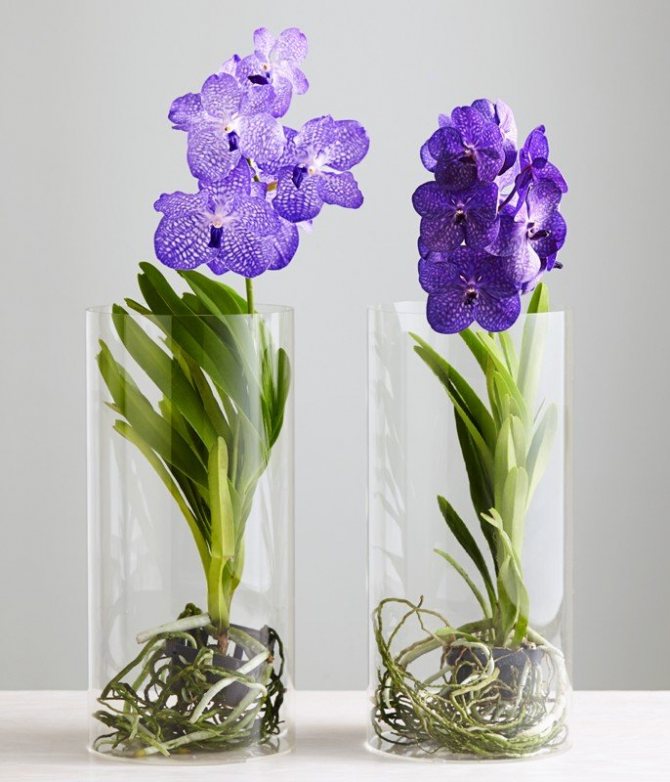

It is very convenient to grow Wanda in a vase.
If you purchased Wanda in a glass flask, then you need to remove the plant from the vase and install in such a way that the upper part of the flower rises above it, and the roots are located inside the flask... When watering, it is enough to pour warm, settled water inside the container and leave it inside for 20-30 minutes. Then the excess moisture must be drained. Between the procedures, the roots should dry well, only after that the next watering can be carried out.
Please note: the roots should not come into contact with the water accumulating at the bottom of the vase or flask, otherwise they will rot.
Flowering secrets
Under favorable conditions and good care, Vanda blooms twice a year, without requiring additional stimulation.
If your orchid does not want to bloom in any way, then it is necessary to change the conditions of detention or organize a stressful situation for the plant.
An excellent stimulator of flowering is a rather large difference between day and night temperatures, it should be about ten degrees... It is rather difficult to achieve such a difference in room conditions, so in summer it is preferable to keep Wanda on the balcony, and in winter to move the pot closer to the window in the evening, and in the morning, on the contrary, move it away from it.


With good care, Wanda blooms twice a year
When the orchid faded and the peduncle began to dry out, it was time for pruning. Using a pruner, knife or scissors, cut it off, leaving a small stump about 1 cm at the base. Cover the cut with beeswax.
What to do during the rest period
Wanda does not have a pronounced rest period... However, after the end of flowering, she needs to arrange a rest - to reduce the number of waterings and stop feeding. The temperature of the content should also be reduced to 16-18 degrees. All these activities are needed in order for the plant to gain strength before the next flowering.
Growth and flowering
The wanda orchid does not have a dormant period. It grows and blooms all year round, but only in the presence of bright sunlight and regular moisture.
If the orchid does not have enough light, then growth may slow down or stop altogether. The leaves take on a richer color and grow longer than during good lighting. The roots become covered with white skin and stop growing. The orchid enters a forced dormancy period.
If it is not possible to increase the light intensity, then it is necessary to adjust the watering.
- When dormant, the plant consumes very little water.But there is a danger that the orchid will start eating itself without getting enough light and moisture.
- Also, irreversible changes occur in the juice - toxins appear. This causes abundant leaf fall and shrinkage of the stem.
For successful planting of peduncles, Wanda needs at least 45,000 Lux of sunlight. Therefore, in our latitudes, the orchid blooms in the spring-summer period or in early autumn.
According to collectors' observations, Wanda must grow 3 leaf plates, after which flowering begins.
The peduncle appears from the leaf axil, develops slowly. If during this period the light intensity drops for a long time, for example, it rains, then the orchid can dry out the peduncle at any stage of its development.
The opened flowers in the first days are pale in color and small in size. Over the next time, they gain color and increase in diameter. During its life, the flower can grow by 4-6 cm from its original size.
Under favorable and optimal conditions, Vanda can grow up to 1 m.The leaf span varies from 40 to 70 cm.
Problem solving: how to save a dying Wanda
Sunburn and other consequences of improper care - table
| Problem | Possible reason | How to fix the situation |
| Roots rotted | Waterlogging |
|
| Buds fall off | Too little watering or pests |
|
| Leaf blades turn yellow | Lean watering |
|
| Brown spots on the leaves | Sunburn | Move the flower to a different place or shade it with tulle. |
| Wanda grows horizontally, droops | Not enough light | Move the flower to a different location. |
| Soft brown spots on the leaves | Fungal disease from waterlogging, including at low temperatures in the room |
|
| Wanda does not bloom | Any care mistake or lack of light |
|
A plant weakened by improper care becomes an easy prey for insects and pathogenic microbes.
Diseases and pests of orchids - table
| Diseases and pests | Signs | Reason for appearance | Treatment and prevention measures |
| Fusarium wilting |
|
|
|
| Chlorosis | Yellow streaks on the leaves | The plant lacks iron |
|
| Root rot |
| Waterlogging |
|
| Spider mite |
| Dry indoor air |
|
| Shield aphid (scale insect) |
| Insufficient humidity in the room | You can get rid of the scale insect using mechanical treatment: scrape off the tubercles and wash all parts of the plant with a cotton swab dipped in soapy water. |


Fusarium is a dangerous fungal disease that Wanda orchid often suffers from.
Resuscitation of a plant without roots
In the treatment of root rot, fusarium wilting, as well as from old age or due to improper care, Vanda is often left without roots. In this case, urgent resuscitation of the orchid is necessary. It is necessary to create conditions for it to grow new fleshy roots.
Hanging
The easiest way is to hang Wanda in a semi-shaded place:
- Remove the plant from the old substrate and cut off all damaged parts.
- Secure the remainder with wire and hang in a semi-shaded place with the top pointing down.
- Make a solution of special fertilizer for orchids in half the recommended concentration and add granulated sugar to it (all components of the nutrient mixture must be taken in equal parts).
- Spray the whole plant with the resulting solution daily.
- The duration of such resuscitation can vary from two to three months.
- After new roots grow up to 3–4 cm, turn the orchid over and plant it in a pot with a substrate.


The easiest way to resuscitate an orchid is to hang it
Greenhouse application
If your apartment is not humid enough, then you can revive the orchid in an impromptu greenhouse. However, it is necessary to monitor the plant especially carefully in such conditions, since excessive moisture can destroy it.
Proceed like this:
- In a diseased orchid, cut off all the affected parts and dust the slices with ground cinnamon or brush with greenery.
- Treat the sections with Fitosporin and put a plastic bag on top.
- Hang the resulting greenhouse with the top of the orchid down.
- Remove the bag daily and ventilate the plant, spray the lower part of it with a rooting stimulant.
- In about a month, the roots should appear. Once they are 3–4 cm long, the orchid can be planted in a normal substrate and cared for like a healthy plant.
2.Wanda home care
2.1 Growing at home
Wanda is a rather picky orchid and requires special growing conditions.
The main difficulty when keeping at home is maintaining evenly high air humidity... Since it is quite difficult to do this in an ordinary residential building, such plants are often grown in a specially created window greenhouse or showcase.
↑ Up,


Interestingly, when growing an orchid at home, not standard flower pots are often used, but special blocks, hanging baskets to allow the roots to breathe, or just trellises. The root system is often simply located outside the substrate and it can hang over the edges of the baskets. Sometimes Vanda is placed in glass vases.
You should not take the flower outside even in the summer months - low night temperatures can destroy the plant. You can place the pot on a glazed and sunny balcony or loggia. If the air temperature drops at night below 16 ° C - the plants are brought into the house.
Before leaving the orchid in the fresh air for a day, it is pre-hardened.For hardening, the flower is taken out to the balcony only during the daytime and the time spent there is gradually increased. The wanda does not like a sharp change in any conditions of existence.
↑ Upward,


Place the bushes away from heating appliances in the room.
Wanda does not have a pronounced rest period and it is not necessary to change the conditions of detention in the winter months.
After flowering, it is worth cut off peduncles a couple of centimeters above the base. Perform pruning with a sharpened, sterile pruning shears.
From time to time, dying leaves will appear at the base of the stem - while there are few of them and they are replaced by new, young leaf plates - this is a normal process.
↑ Upward,
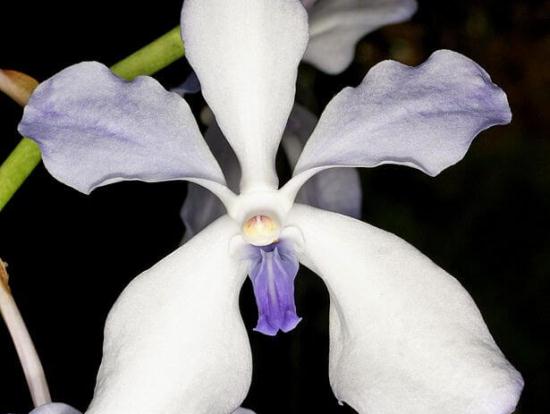

2.2 Breeding Wanda
Wanda breeds lateral processes - this method is the simplest and can be used at home. Unfortunately, such small daughter plants rarely appear. Young daughter plants, ready for separation, should have their own roots in length not less than 5 cm... and leaves.
- The lateral shoots of the wanda are separated with sharp, sterile pruning shears and rooted in nutritious, coarsely fibrous orchid soil.
- The wound surface remaining on the flower is sprinkled with charcoal powder.
- For rooting, small pots with drainage holes are prepared. For daughter bushes, it is better to pick up cramped, narrow containers, since their root system easily rots at first.
- The flower is carefully placed in pots and little by little the containers are filled with orchid substrate, sprinkling the roots of the plants.
- Such flowers are placed in a warm place with an air humidity of 80 - 90% relative.
- From above, the cuttings are covered with glass or transparent plastic, not forgetting to spray and remove condensation.
↑ Upward,
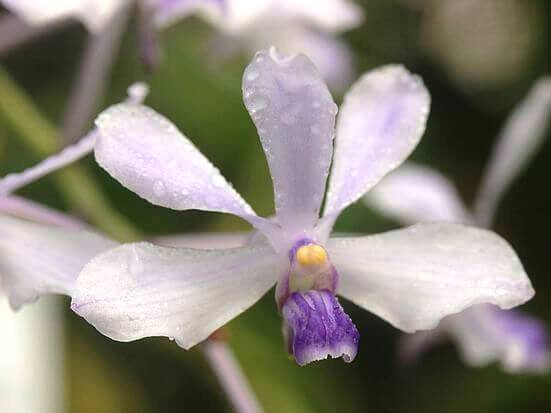

To develop new varieties, breeders use seed propagation, but it will be almost impossible to carry it out at home.
- The top of the shoot can be separated from an adult flower and rooted in spring or summer.
- The wound on the mother plant is sprinkled with crushed charcoal powder.
- The base of the stem cuttings can be dusted with growth hormones and immersed in a moist substrate.
- During the rooting process, it is necessary to maintain a very high air humidity, but you should not water the flower for several days - the base of the cutting can rot if moisture enters.
- A greenhouse is organized on top - they put the pot on a pallet with wet gravel or water so that it does not touch the bottom of the pot and close the flower on top with polyethylene or transparent plastic.
- Cuttings are placed in a warm place with a temperature of about 25 degrees, the location should be closed from direct sunlight.
When new leaves appear on the handle, it will be possible to say that rooting was successful. Unfortunately, rooting takes place over a fairly long period of time - the first root may even appear six months later.
↑ Upward,


2.3 Flowering time
Wandas bloom with proper care 2 or 3 times a year, as long as they receive good care. Orchid can bloom in any seasonbut most often in spring and summer, bright light and cool nights contribute to this.
For the onset of flowering, the plants must be kept in conditions of long daylight hours. Each bloom can last up to 1.5 and even 3 months.
↑ Upward,


2.4 Wanda Transplant
Often transplanting such plants not required - at home, vanda is grown on a bromelium tree or on a block or a special trellis. You can even grow an orchid in a glass vase - this is probably the most popular method at the present time.
For a flower, select a transparent glass vase with a sufficiently narrow throat and place the vanda inside, making sure that the roots are not bent up and do not break.As needed, water is poured into the vase for irrigation and left for 10 to 15 minutes. When air bubbles stop rising from the water, it means that the root system has already absorbed a sufficient amount of moisture and the water can be drained. Such watering is usually carried out once a week.
Wands do not like when their root system is disturbed, so they need to be transplanted as little as possible... Repotting is really necessary when the soil is already completely destroyed and rotting, or when the plant has really outgrown the pot. Aerial roots may be peeking out of the pot, but this is not a sign that a transplant is needed.
↑ Up,
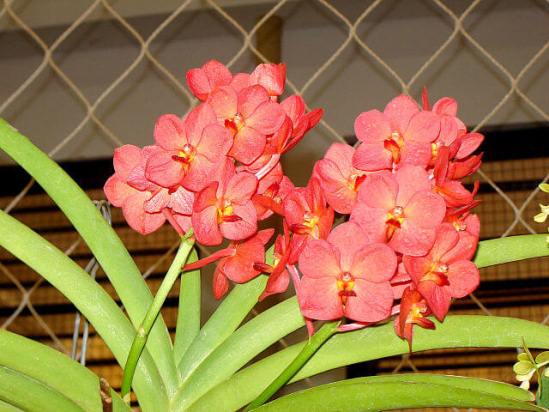

Before transplanting, like most orchids, the flower soaked for 1 - 2 hours in warm water... This procedure will make the roots of the vanda more flexible and they will receive less damage during transplantation.
Vandas should be transplanted into pots with large drainage holes only in the spring, every two to three years... You can place the flower in a wide and shallow bowl and only lightly sprinkle it on top with a rough substrate for orchids.
Trim the damaged roots with a sterile cutting instrument before transplanting.
↑ Up,
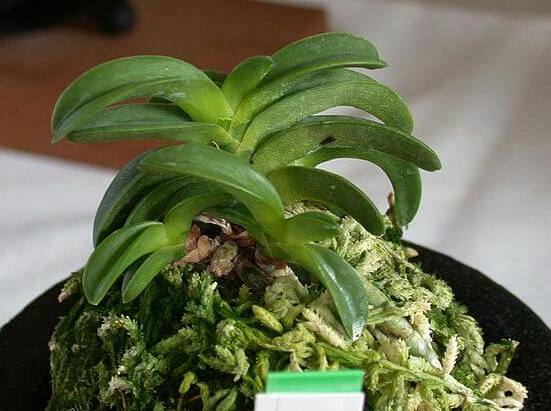

↑ Up,
2.5 Diseases and pests
- Large, rough blackening spots on the leaves are sunburn - move the plant to a light shade.
- Yellowed and faded leaves indicate a lack nitrogen.
- Mosaic virus causes both pale and dark streaks on orchid leaves.
- Wanda is capable interrupt flowering when kept in a dry room.
- Stagnant water in a pot with insufficient drainage can cause root rot.
- Fusarium... Other fungal diseases appear with insufficient air movement or spraying in the evening.
- Leaf spot.
- A large amount of nitrogen will negatively affect flowering - it will less abundant.
↑ Up,
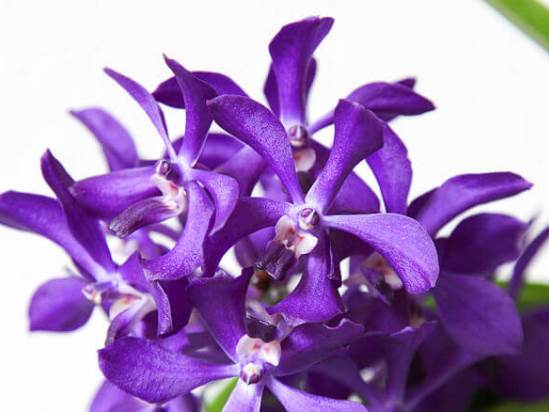

- Flowers are formed in fewer quantities with a lack of nutrients.
- Leaves become soft and as if sluggish with an excess of nutrients.
- Leaf blades can crack if the flower is overcooled or overfed with nitrogen fertilizers.
- If the flower for some reason the root system dies off, then you should not get rid of it - you can grow roots in the greenhouse, but for this you need to be patient.
- Plants can shed the leaves with heatstroke or dry roots.
- Orchdeans may shed buds with insufficient watering.
- If there is a lack of moisture, turn yellow leaf plates.
↑ Up,
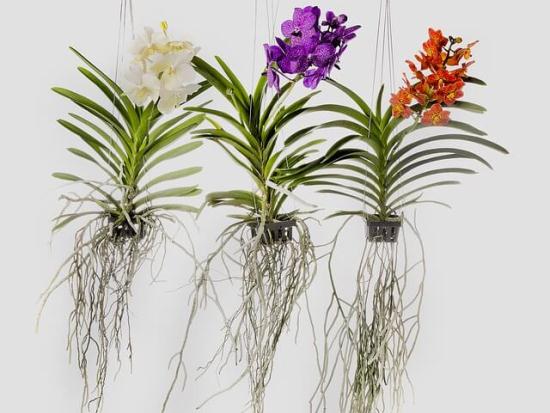

From insects, the plant can be attacked by mealybugs, spider mites, aphids, scale insects, wood lice, millipedes, whiteflies, thrips. If you take the orchid outside, then slugs and snails can settle on it.
↑ Up,
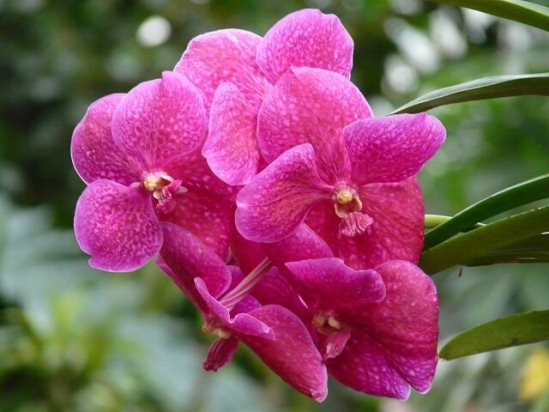

2.6 Feeding Wanda
During the period of active growth, regularly feed the plants with complex fertilizers for orchids. every week... Wanda loves feeding very much and will thank the owner with abundant flowering if she gets enough nutrients.
During the winter months, reduce the frequency of feeding to Once a month... Remember not to fertilize your orchid when it is nearly dry, as this can cause serious root damage. Water the plant and fertilize immediately after watering.
↑ Up,


Both root andfoliar fertilizerswhen the nutrient solution is sprayed onto the leaves. When growing with open roots, the nutrient solution can also be applied to the root system.
It is not necessary to use fertilizing plants rich in nitrogen - in response to this element, the orchid will grow leaves abundantly, however, it will form fewer buds. For the onset of flowering, elements such as are important phosphorus and potassium.
↑ Up,


2.7 Containment Temperature
Daytime temperatures range from 24 ° C to 35 ° C, and nighttime temperatures range from 16 - 21 ° C.It is better for plants to provide daily temperature difference, which should be about 8 ° C. In autumn, low night temperatures stimulate the formation of peduncles.
Plants should not be exposed to temperatures below 15 ° C at any time of the year.
Sufficiently high temperatures cause the vanda to grow faster, but at the same time it is necessary to maintain high humidity and air circulation, and also water the orchid more often. The strongest summer heat is not capable of harming this flower with adequate watering and high humidity.
↑ Up,


2.8 Lighting
Provide bright light throughout the year and the orchid will reward you with abundant blooms. maybe additional illumination with fluorescent or LED lamps short winter days. In order for the plants to look healthy and feel good, they need a long day of light at least 12 - 14 hours.
Artificial lighting is turned on in the morning and in the evening, extending the length of daylight hours. Plants must rest at night. In the dark.
Direct sunlight can cause leaf burns, so the plants are shaded from them. The flower can take sun baths in the morning and in the evening - for 3 - 4 hours daily. A sharp change in illumination should not be allowed.
↑ Up,
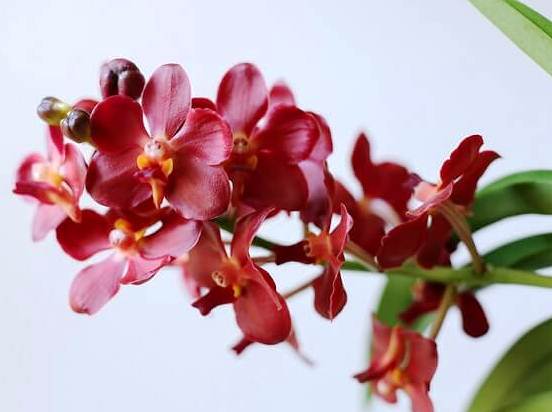

Light levels for orchids can be easily adjusted by simply observing the plants closely. In low light, flowers produce more chlorophyll and leaf blades darken... With a lot of sunlight, the leaves become more bright... Also, in partial shade, the leaf blades become larger.
A pot or vase with a root system should be protected from sunlight on hot days - vanda roots do not like overheating.
Wands are developing wellon the east and west windowsills, when containing from the south side the flower is placed in the back of the room or closed from the direct sun with a curtain. Shading should accompany the orchid from 10 am to 4 pm.
↑ Up,
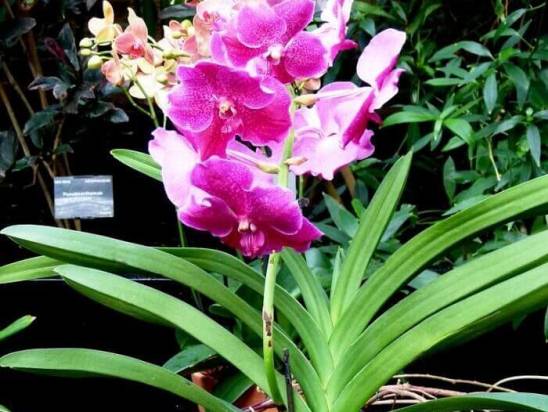

2.9 Soil
Should contain large pieces of pine bark, coconut shells, charcoal. You can add a little sphagnum moss to the soil - it will increase the moisture content of the mixture, but you cannot overdo it with this component.
Wands prefer clay pots over plastic ones, as the walls of the clay pots breathe, allowing air to reach the roots of the orchid.
↑ Up,
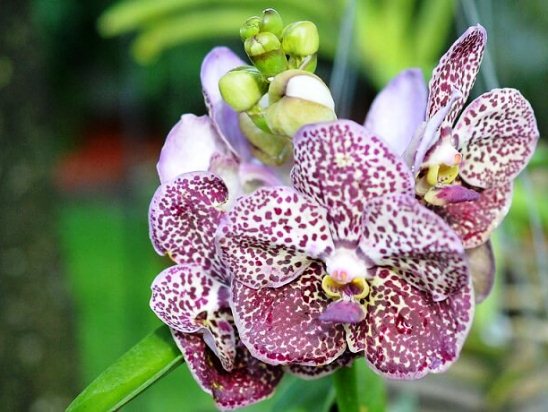

Wandas are epiphytes, which means that their aerial roots take nutrients and moisture from the surrounding atmosphere. The larger pieces of pine bark are placed in the substrate, the better. Often this plant is grown without the use of soil at all.
The flower does not make any requirements for the content of nutrients. If kept in a substrate with insufficient air circulation, the roots can rot.
2.10 Watering
Since the wanda does not have such storage organs as pseudobulbs, it is worth monitoring watering carefully - avoiding overdrying or stagnation of moisture.
Wands are watered with warm water in the morning. Water for irrigation should be at least room temperature, but it is better to warm it up to 25 - 30˚C... If you are growing orchids in hanging baskets, you can water it daily.
In the warm season, watering should be frequent and abundant; in the cold months, the frequency of watering is reduced, slightly drying the top layer of the soil. Overdrying the roots during the flowering period will lead to the appearance of deformed and underdeveloped buds. Reduce watering frequency after flowering by 2 - 4 weeks.
↑ Up,
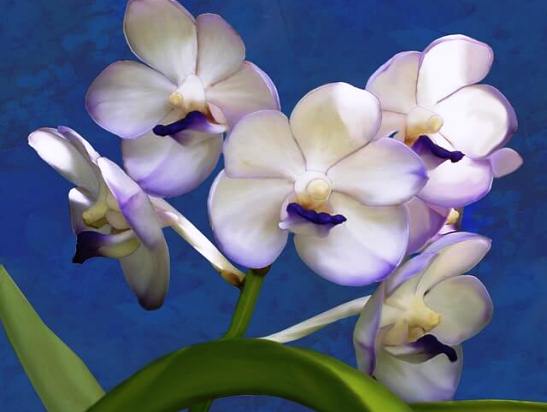

With the onset of summer heat, you can use bottom irrigationby immersing the wanda pot in a large container of water for a few minutes. Excess moisture that appears in the pallet after such a bath must be drained.Bottom watering will help the potted substrate, and especially large pieces of pine bark, become saturated with moisture and, as needed, will give it to the roots of the flower.
If the flower is contained in a pot, then the excess moisture that appears in the pan after watering is drained after a few minutes.
↑ Upward,
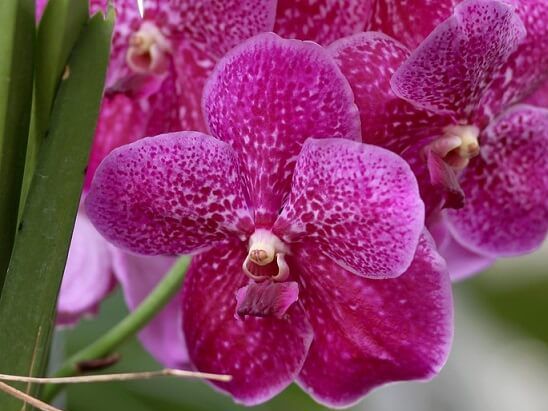

Orchids are very sensitive to water quality - it must be filtered or softened with peat. Since the flower does not like the salts contained in tap water, it is recommended to water it with melt or rain water, but it should be collected away from industrial areas and busy highways.
Lemon juice or a few grains of citric acid can be added monthly to the water for irrigation.
↑ Upward,
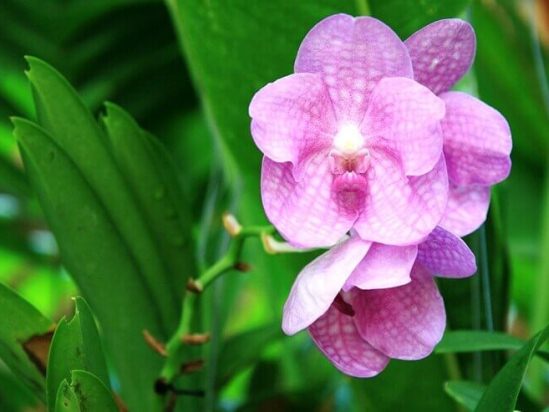

2.11 Spraying
Orchids demand very high humidity... The relative humidity level, which is ideal for a wanda, is within 75 — 85 %however, if the flower is kept in excess moisture without air circulation, it can be affected by diseases and rot.
It is important to remember that the higher the humidity level you maintain, the more air movement should be. It will not be superfluous to place a working fan in the room in the orchid.
Put the pot on pallet with wet pebbles or use humidifier... You can also spray flower in the morning, so that moisture has time to evaporate from the flower before nightfall.
↑ Upward,


The spray water temperature should also exceed room temperature by 4 - 6 degrees. Spraying will have a positive effect on the root system of the flower if it is grown on the block.
Do not use unstable tap water for spraying - it will leave ugly whitish marks on the surface of the leaves. When growing on a pallet with wet pebbles, make sure the water level is always below the bottom of the pot.
↑ Upward,
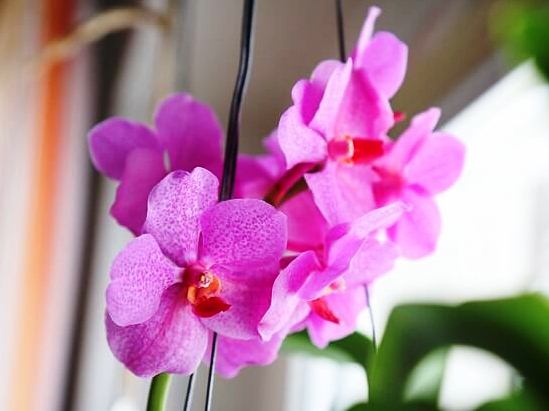

The alternation of dry and humid air has an extremely negative effect on the flower.
Plants should not be exposed to cold drafts - they can become fatal to the flower.
In the summer, the orchid is happy take a shower with warm water. Do not rush to take the flower out of the bathroom after water procedures - the hot and humid atmosphere will only benefit the orchid. After 40 - 60 minutes after the shower, the surface of the leaves and especially the leaf sinuses should be blotted with paper towels.
↑ Upward,


↑ Upward,


2.12 Purpose
Most often wands are grown in hanging baskets... Flowers do not lose their attractiveness for a long time in a vase of water (up to 2 weeks), so Vanda is often used for cutting.
↑ Upward,
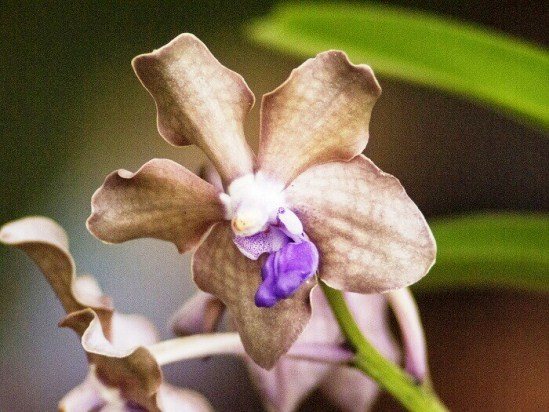

2.13 Note
Currently, breeders are working to adapt the vanda to living quarters as much as possible and the orchid is becoming more and more common in homes and flower shops.
With proper care and creation of suitable conditions, the age of a flower can be at least 30 years old.
Interestingly, in Poland it is believed that Wanda has medicinal properties and the flower is used for diseases of the upper respiratory tract and for the relief of the symptoms of neuralgia.
Hydroponics.
Reproduction of the Vanda orchid: by seeds - no, by daughter processes (children) - yes
In nature, Wanda reproduces both vegetatively and by seeds. However, at home, the seeds do not germinate; only hybridizers use this method. The only effective method of breeding Wanda "in captivity" is vegetative. You can get young specimens by separating the root rosettes (children), which are formed at the base of an adult orchid..
Orchid planting:
- Use a clean knife to separate the babies from the mother plant.
- Sprinkle the slices with crushed activated charcoal or ground cinnamon.
- Plant the daughter shoots in small plastic nets with a mixture of bark pieces, charcoal, and sphagnum moss.
- Secure young plants vertically using any means at hand.
- Cover the planting with a clear glass lid.
- Ventilate the greenhouse every day and wipe off any condensation.
- Spray the plants periodically.
- When the roots grow back and anchor in the soil, remove the greenhouse and support.
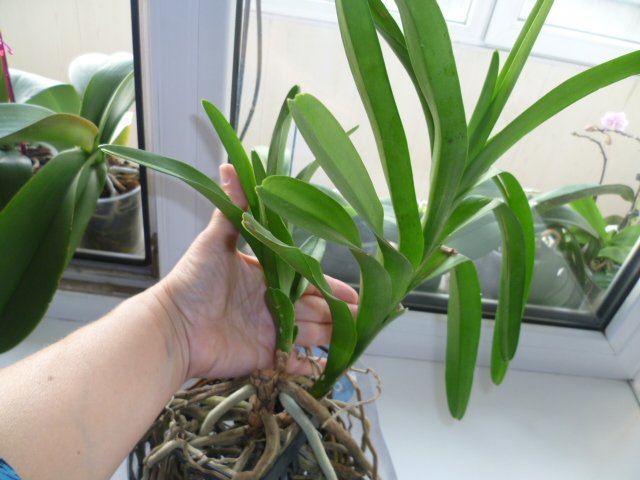

The only effective way of reproduction of Wanda is the separation of daughter shoots during transplantation.
Florist reviews
I have always dreamed of learning more about orchids, looking at them in the wild. I wanted to buy copies that differ from the popular Phalaenopsis. And in Thailand, in Bangkok's duty-free shop, I finally met my favorite - the Blue Vanda orchid. Thais cultivate orchids on special farms, orchid gardens are found in tourist places (for example, the famous Nong Nooch in Pattaya), and they have many varieties of Vanda, but it was the blue that caught me.
Lifehack
Colleagues presented me with this wonderful flower for my birthday! I myself would hardly have bought one - the price is 3000–3500 ... I have not seen such beauty in flower shops and was pleasantly surprised! First: a vase is a huge glass cylinder in which a flower is placed. Secondly: this plant does not look like an ordinary phalaenopsis - the roots are more powerful and a bunch of fleshy green leaves. Thirdly: the size of the flowers themselves - beautiful delicate and very large flowers are located on one peduncle ... I got bright purple ones)))) Fourthly: the plant does not need to be transplanted and any soil added, right in the cylinder it grows , only you need to raise it above the edge of the vase so that the roots remain inside, and the peduncle and leaves are outside. Fifthly: watering is obscenely simple - fill the vase halfway with water for 20 minutes, then drain all the water. And so once a week or two. In general, I'm immensely happy))) I will try to keep this beauty and get more than one flowering, I hope it will work out))))
Vivica
I have many favorite colors, and this one is special and the most desirable in my home collection! When I bought it, the store said it was Wanda "Michelle". But after the lapse of time, I realized that this is a hybrid of Wanda and Ascocenda. 1) Easy care; 2) Illumination should be good, you need to choose either a special place or a bright window sill; 3) It blooms with insanely beautiful flowers, with a long flowering; 4) The price is not always and not everyone can afford it (I already bought with faded flowers, so the store gave me a 30% discount)
pups16


